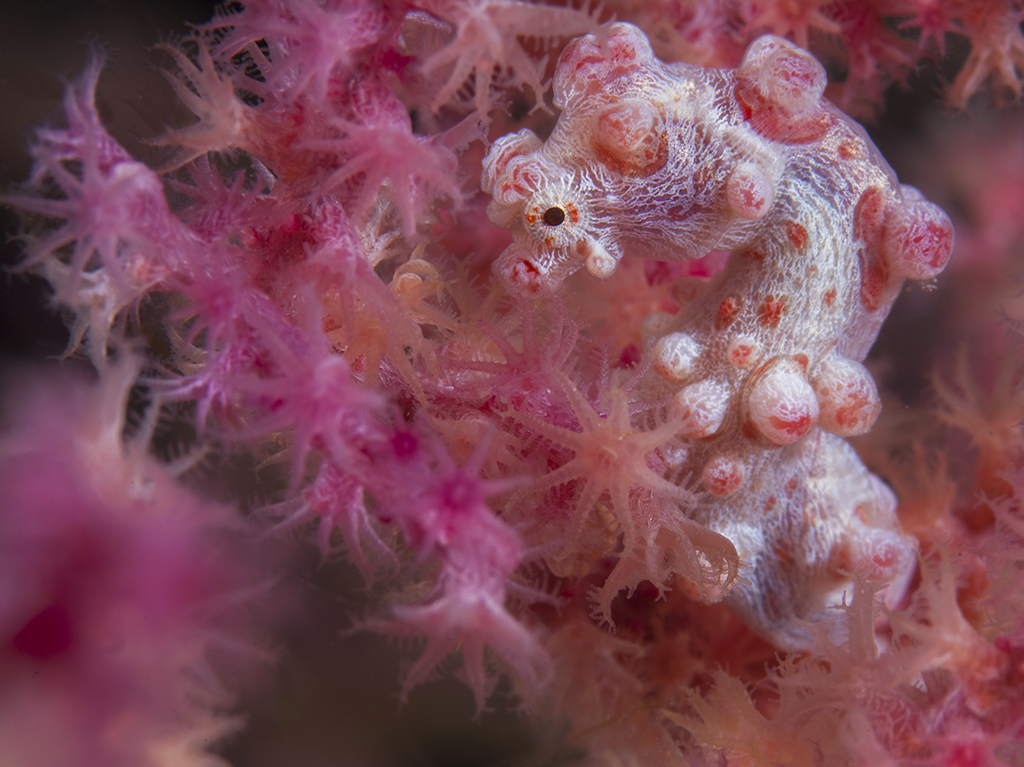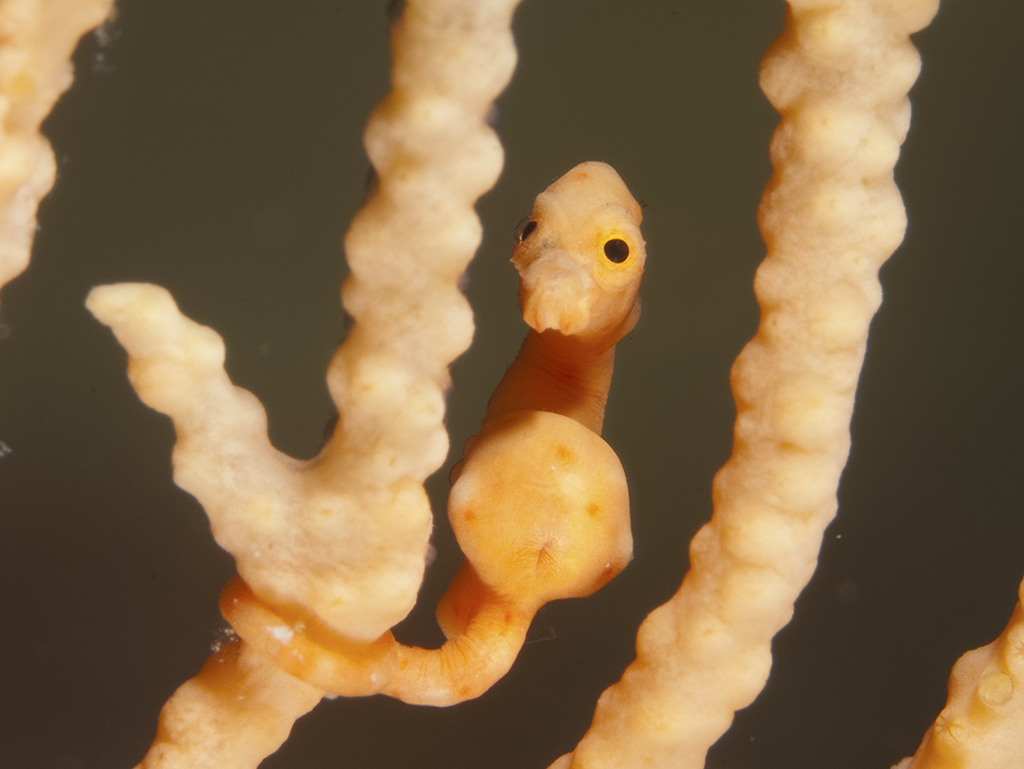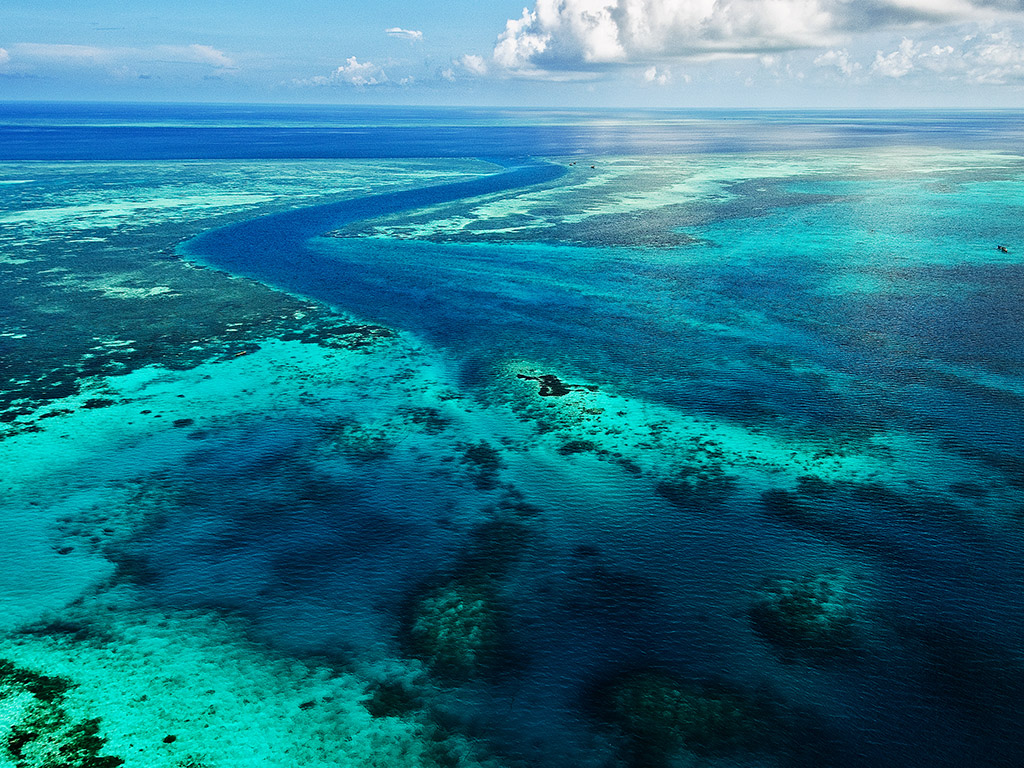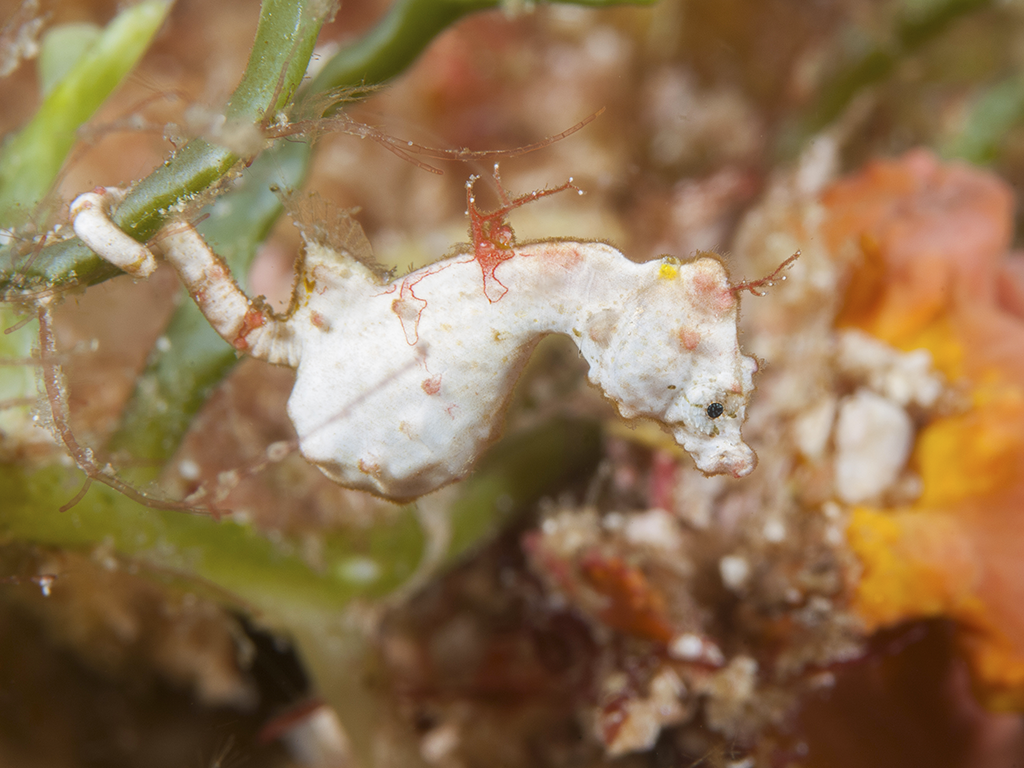Horses of a different color
Pygmy seahorses are animals that few people have been lucky enough to see, let alone witness mating or giving birth. But at Wakatobi, divers are granted this pleasure all the time. Follow along to learn about these unique and rare animals, and why Wakatobi is one of the best places on earth to see them.
Though you might not guess it based on name or appearance, seahorses are actually fish, and pygmy seahorses are some of the smallest fishes in the sea–the largest specimens would barely stretch across a silver dollar coin. “Wakatobi is one of the best places for pygmy seahorse research in terms of number of species and their abundance,” says Dr. Richard Smith. “Ease of access and sheer diversity on the house reef has been vital for my studies as this is where I carry out much of my observations.”

Bargibant’s pygmy seahorse (Hippocampus bargibanti) was discovered in 1969 by researcher George Bargibanti, while he inspected a large Muricella sea fan. Photo by Dr. Richard Smith
Their tiny size and near-perfect camouflage kept pygmies hidden from humans until very recently. Now, however, they have become superstars of Indian Ocean reefs, and the favorite subject of a growing number of photographers who devote many hours to the search for these tiny, elusive creatures. Dr. Richard Smith made pygmy seahorses the subject of his doctoral dissertation, and has shared some of his findings and images at his website www.OceanRealmImages.com. Here is some of the highlights:

Pygmy seahorses are ovoviviparous, but unlike most animals, the male carries the eggs, which are contained in a pouch on his underside. Photo by Dr. Richard Smith
Somewhere in the evolutionary process, seahorses lost many of the features that identify them as fish. Their fins are tiny, their tails have become more monkey-like than fishy, and their mouths have morphed into puckered snouts. Even more unusual than their appearances, however, are their mating and reproductive cycles. Partners practice strict monogamy, and become partners for life. And in a rare reversal of roles, it is the males who become pregnant and carry the eggs until birth. Male pygmy seahorses can be distinguished by a slit like opening at the base of their abdomen, visible in the image above. Females on the other hand, have a raised circular pore.

George Bargibanti, a researcher at the Museum of New Caledonian in the South Pacific, discovered Hippocampus bargibanti in 1969. Photo by Richard Smith
The first pygmy seahorses were discovered by George Bargibant in 1969 and named in his honor a year later. George, a researcher at the Museum of New Caledonian in the South Pacific, discovered Hippocampus bargibanti while inspecting a large Muricella sea fan being added to the collection. On the surface of the sea fan he found a pair of tiny seahorses measuring just less than an inch in length and with color and texture that perfectly matched their coral home. Notice that the tubercles, or bumps, that cover pygmy seahorses match the closed polyps of their host seafan in both colour and prominence.
Bargibant’s pygmy seahorses live in small groups in association with sea fans of the genus Muricella. Open polyps such as on this orange seafan, make images of pygmy seahorses much more appealing. Polyps will quickly close if the delicate sea fan (aka gorgonian) is touched and care should be taken not to touch them.
After their initial discovery, pygmy seahorses remained relatively unknown for the next twenty odd years, until SCUBA divers began to notice them in the mid 1990’s, and a craze for these enigmatic creatures began. Divers began scrutinizing every detail of habitats like seafans in hopes of finding a perfectly camouflaged pygmy hiding in plain sight.
As word of the pygmies’ existence spread, a flurry of new discoveries was fueled by divers who fanned out on the reefs of Southeast Asia searching for these tiny creatures. Six of the seven known pygmy species were named after the year 2000, and new discoveries are still being made to this day. If ever there was an opportunity for the average diver to make a unique scientific discovery, this is it. For example, the Pontoh’s pygmy (Hippocampus pontohi) such as the one in the image above, was named in 2008.
Free-living pygmy seahorses, such as the Pontoh’s, can be found living anywhere on the reef, but tend to have a well-defined home range that they share with their partner. The Pontoh’s pygmy seahorse prefers much shallower areas of the reef than gorgonian-associated species. Wakatobi is one of the best places in the world to see Pontoh’s pygmies. The Pontoh’s above was found in Wakatobi’s shallow seagrass just off the beach.
Pygmies differ slightly from their larger seahorse cousins, as they have undergone some physical adaptations for their small size. One distinguishing characteristic is that they have a single gill opening rather than a pair. There are few physical differences between male and female pygmies. The most reliable indication is the slit-like opening on males and a raised circular opening in females. In addition, pygmy males brood the developing young within a pouch located on the trunk of their body rather than the tail.

Hippocampus denise, also known as Denise’s pygmy seahorse, was discovered by Wakatobi guest Denise Tackett. Photo by Cor Bosman
The Denise’s pygmy seahorse is extremely variable and clearly distinguished from the Bargibant’s by its more slender body shape and longer snout. These three Denise’s were photographed with extreme care. Because these tiny fish do not have eyelids and are sensitive to bright lights it is also important to limit the number of flash-lit images and the use of flashlights.
Species like this cannot live without their host sea fan; the extreme camouflage that makes them near invisible on the sea fan would be obvious to predators anywhere else. This unusually bumpy Denise’s pygmy is perfectly camouflaged in a Villogorgia seafan.

If a female seahorse’s mate isn’t able to accept the egg, she risks wasting them, or worse they could fester and kill her. Photo by Richard Smith
A clutch of eggs represents a significant investment of energy for a female seahorse and if her mate isn’t able to accept the eggs she risks wasting them, or worse they may fester and kill her. The function of the pair’s courtship displays is to establish the exact stage of their partner’s reproductive cycle, allowing the transfer of eggs as quickly as possible after the male gives birth.

More than a decade ago Wakatobi dive resort created a marine reserve, which protects over twelve miles of reef and provides an ideal environment for pygmy seahorses to thrive. These reefs are now known as one of the most prolific areas for witnessing various species of pygmies. Photo by Didi Lotze
Located directly adjacent to a rich lagoon and drop off, Wakatobi dive resort, in southeast Sulawesi, Indonesia, is an ideal location for observing many pygmy seahorse species. Typically, on any given dive or snorkel, Wakatobi’s keen-eyed guides will spot them perched gracefully for divers to take a peek. (photo Walt Stearns)

Pygmy seahorses are animals that few people have been lucky enough to see, let alone witness mating or giving birth. Come to Wakatobi and see for yourself some of these amazing and fascinating creatures. Photo by Mark Snyder
See for yourself some of these amazing and fascinating creatures. Inquire directly at office@wakatobi.com or complete a quick trip inquiry at wakatobi.com.


